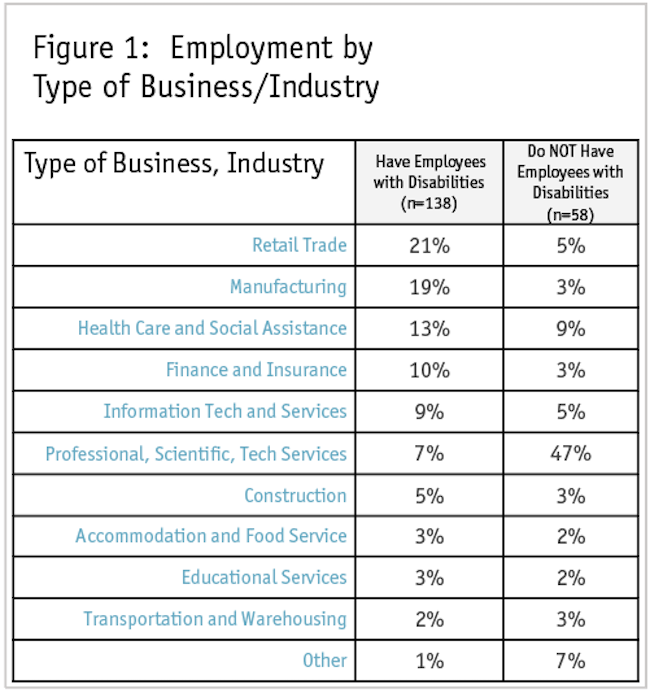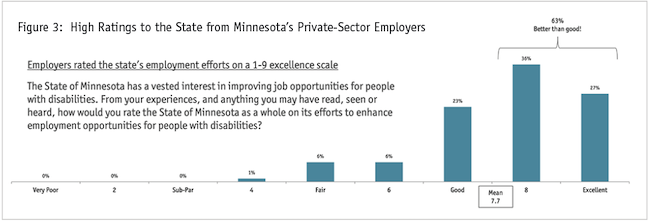Everyone wins
Editor's note: Tom Pearson is managing director and founding partner of MarketResponse International. He can be reached at t.pearson@marketresponse.com. The author wishes to acknowledge the work of MarketResponse International’s Qualitative Research Moderator Derek Pearson, Senior Research Director Susan McCullough and Senior Research Analyst Lynn Schreifels on this project.
In this article we share the findings from qualitative and quantitative research conducted among employers in Minnesota earlier this year which uncovered surprising insights on the positive effects that people with disabilities in the workforce have had on their fellow employees and the companies they work for. The insights show how an exemplary public and private sector partnership is resulting in broader societal benefits from enhancing diversity, equity and inclusion (DEI) for people with developmental disabilities.
The Americans with Disabilities Act (ADA), signed into law in 1990, is a comprehensive federal civil rights statute protecting the rights of people with disabilities. It has had a major impact on access and inclusion to employment opportunities for people with disabilities, which in turn has greatly enhanced their chances for equity and inclusion in society in general.
Title I of the ADA applies to employers with 15 or more employees. It prohibits discrimination in recruitment, hiring, promotions, training, pay, social activities and other privileges of employment. It restricts questions that can be asked about an applicant’s disability before a job offer is made. It also requires that employers provide “reasonable accommodations” to the known physical or mental limitations of otherwise qualified individuals with disabilities, unless it results in undue hardship.
Two phases of research were completed among employers in Minnesota in the first quarter of 2023:
Phase I: Qualitative research was conducted to gather knowledge and experiences to inform the design of a quantitative survey of employers:
- In-depth interviews (IDIs) with subject-matter experts in state government and the private sector (n=6).
- In-depth interviews among employers of individuals with developmental disabilities (n=10).
- Each IDI took 40-50 minutes to complete and was conducted using a web-based audiovisual platform, enabling representation from of a wide variety of industries and locations from around the state.
Phase II: Quantitative survey of businesses in Minnesota, n=200, from an opt-in panel of business managers. Research objectives:
- obtain measures of current employment of people with developmental disabilities and other disabilities;
- gauge employers’ attitudes regarding employment of people with disabilities;
- gain insights regarding the future outlook for employment of people with disabilities.
Among employers in Minnesota, at locations with five or more employees, two-thirds employ people with disabilities, the majority of whom (eight of 10) have a developmental disability. These companies tend to be much larger and more likely to be involved in retail trade or manufacturing, compared to those that do not currently employ people with disabilities (Figure 1).

One hypothesis we had going into this research was that companies were motivated to employ people with disabilities, more today than in the past, simply because of the historic shortage of workers after the pandemic. However, we found that more important reasons were having a company culture that embraces diversity and a workforce that matches the profile of people in their communities (Figure 2).

Some employers are hesitant to employ people with disabilities simply because of fear of the unknown. Concerns were expressed during the research by subject-matter experts about the potential complexities of employing, managing and working with people with disabilities.
They're scared, right? Like, “I don't know how to manage that person. I don't know how to talk to that person.” So, there's kind of a fear factor that nobody would admit to.
Current non-employers of people with disabilities are most concerned about senior management reactions to their hiring decisions, as well as concerns for safety and costs of employing people with disabilities.
Government involvement is essential
Among the population of people with developmental disabilities, no two individuals are alike, as they cover the full spectrums of cognitive, social and emotional skills and abilities. Consequently, government involvement is essential in helping individuals with disabilities find the best fit among potential employers and coaching them through the application and onboarding processes.
In addition, many company managers lack experience in working with people with disabilities, which explains why 57% of the businesses that employ people with disabilities were assisted by Vocational Rehabilitation Services (VRS) from the Minnesota Department of Employment and Economic Development (DEED), and many were assisted by other government and non-government employment services. One company respondent had this to say about VRS:
I’m not a special ed teacher, I don’t have the training. I partner with Vocational Rehabilitation (Services); they have the understanding. They come into my business and learn what we need. It’s scary, but partner with an expert and they’ll help with the process.
Need for flexibility and accommodations
Flexibility in hiring processes is often required of companies that employ people with disabilities. An experienced employer of people with disabilities said this:
Our hiring process is maybe slightly modified depending on what the candidate needs … If somebody needs their job coach to come along with him to the interview, that's completely fine. If there's some other assistance that they need, we talk through that before the interview process.
Some companies are able and willing to customize job descriptions to fit the needs of the employee. For example, they may split some job tasks into part-time positions in order for the employee to maintain eligibility for assistance they may be getting from the government:
Some of the people [we’ve hired] were getting some sort of assistance, [which means] they can only make so much money. We ended up shortening up hours to make sure they never made more than what they could. And what happened a lot of times is that they could make more money working than they were getting for assistance. So, they would drop the assistance and just want to keep working; and either was fine with us.
However, that level of customization is not doable in companies that need more consistently defined hiring protocols:
Customized employment is an awesome concept but to [some] employers it sounds like you're creating a brand-new job, which can be a very scary prospect. Like what is that job, who do they report to? How does that work? Why are we creating a new job? We can’t just put new jobs together willy nilly, without vetting from our legal team and having an appropriate business need.
Title I of the ADA requires that employers provide “reasonable accommodations” to the known physical or mental limitations of otherwise qualified individuals with disabilities unless doing so results in undue hardship. Just over half of the employers in our survey have needed to provide some forms of physical and/or process accommodation for their employees with disabilities. The most often provided forms of accommodations were as follows:
Physical accommodations
- Provided technology to help the employee function in the workplace (such as voice recognition software or a specially designed computer keyboard)
- Modified physical environment (ramps, adapt desk to wheelchair)
- Provided accessible parking
Process accommodations
- Allowed employee to work from home
- Changed pre-employment screening procedures
- Provided transportation accommodations
Half of the accommodations made for people with disabilities cost their employers less than $1,000; about a third (35%) cost between $1,000 and $5,000. Though costs were more than anticipated for 28% of employers, only 3% believed the costs of accommodations outweighed the benefits of employing people with disabilities.
Valued and appreciated
Employers appear to be equally satisfied with employees with disabilities as they are with their employees without disabilities but for different reasons. Employees with disabilities are valued and appreciated for their positive attitude, loyalty and impact on other employees and their companies as a whole.
The most amazing thing I saw was the complaining almost stopped from my current employees. It was unbelievable. They got to see how important it was to somebody else. It changed the whole attitude and people became very accepting, very forgiving, very understanding. It was amazing to see how my own people changed for the better when we started doing this.
Exemplary partnership

Towards the end of the survey the employers gave very high ratings to the state, illustrating the exemplary public/private sector partnership that exists in Minnesota for enhancing employment for people with disabilities (Figure 3). Professionals from DEED, along with its partnering organizations, work directly with businesses to help them find the right candidates, resulting in successful employment for people with disabilities. If contacted by DEED or one of its partnering organizations: 90% of companies that currently employ persons with disabilities would be likely to pursue hiring others; and among employers that currently do not employ people with disabilities, 70% would be likely to pursue that possibility if contacted by DEED or one of its partnering organizations.